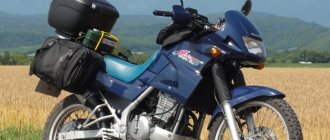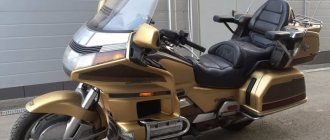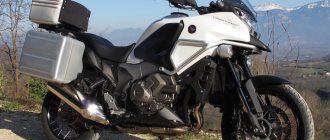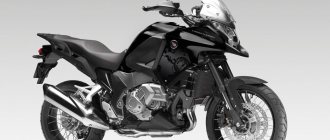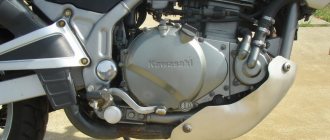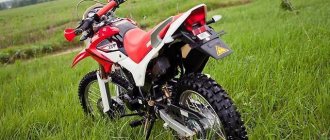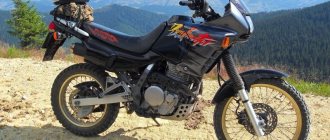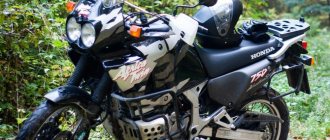Bike features
Here are the main advantages of the Honda XL 400 V Transalp:
- protection of the crankcase and driver's hands;
- high performance with small dimensions;
- excellent handling.
The bike is an example of what a high-end enduro should look like. Even its name speaks about this: it would hardly be possible to choose something more harmonious and attractive than Transalp. You immediately imagine a high-altitude Austrian or Swiss highway along which this beautiful car confidently rushes through the Alps.
Engine
A distinctive feature of the engine is that it is V-shaped. Not every enduro can boast of this. This four-stroke unit has two cylinders. Each of the latter has three valves. The working volume reaches 398 cm³. The unit is liquid cooled.
The maximum characteristics of the engine are as follows: its torque at 6500 rpm is 34 Nm, and its power at 8500 rpm reaches 37 hp. The speed of the Honda XL 400 V Transalp at its peak is 160 km/h, while the motorcycle will accelerate to 100 km/h in 6.5 seconds.
Review of the Honda XL 400 V Transalp motorcycle
Despite the fact that the 400th Transalp is really weak with only 37 horses, it is capable of a lot. The front wheel steers fabulously at 21; such a wheel doesn’t care about decent irregularities. I walked along the dirt road for a hundred and even got high, it fell like I was on rails, scraped onto the asphalt 140 mot makes it easy further, the acceleration is sluggish, but even driving at such a speed on an endurike, wearing a helmet, the noise presses on my chest. Today in the evening I think I’ll eat a little. It’s been raining outside all day and it’s still a blast to drive. The ruts were as deep as the wheels in some places, but he didn’t give a damn. I drove to a neighboring area and returned in the dark; neither the rain nor the shitty road spoiled my mood. The brakes are a bit weak, but if you get the hang of it, they are quite predictable. The Transalp is definitely not an SUV, but a road bike, but it can handle any kind of road. I’m sure we will visit many interesting places with it. This is how my new season began.
The motorbike was bought at an auction in the winter, we won’t talk about the price, the mileage of the motorbike was not great, only 27,000 kilometers, during the season we managed to drive another 23,000, so here you have a tranny with a mileage of 50 units.
Of course, there were both positive and negative aspects, but I probably won’t be able to highlight anything in particular, because both the pros and cons - it depends on what point you look at it, but one thing is indisputable - Hondas don’t break - a fact. I read on the Internet that the transic is very strong against falling - I confirm this, there is a fact that I applied mine twice and both were extreme, there were also cases when I dropped it while standing still and fell with it, but these do not count.
Now, regarding the suspension of the tranny, there are some complaints, but I should note that I weigh a hundred kilos, and that’s not a little. It is impossible to consider a transalp as an endurik because it is not one. Therefore, we will evaluate it as a road motorcycle, in this capacity it is at its best, it can handle any roads, but still roads. The ground clearance is too small, we are afraid of the engine swaying, we hit our belly on the road several times, but the lowest point is the central stand, and thanks to it, the crankcase didn’t do anything. The suspensions are good enough for them to handle almost everything that our roads could present, including the Chita-Khabarovsk section, which we passed twice today, and we were lucky to get there both in the dry and in the rain - on muddy clay and wet sand. On Olkhon, the roads are sandy and there we easily drove a hundred and in some places even more. I even turned off the road and just drove along the steppe, climbed hills, made my way through rocky areas, so he could do a little off-roading, but only without fanaticism. There were several breakdowns in the fork, but they were entirely my fault. The bump stop on the rear shock absorber fell apart and it was also my fault, I didn’t notice. Look at the photo of the tranny where he has front turn signals, we drove into the water almost right up to these same turn signals and he didn’t even sneeze. Not a single breakdown during the season, not a single puncture.
The tranny and, as it turns out, its older sister Africa have the same design flaw - this is a shitty plastic mount on the face of the moto, it broke both for me and on the Africans I met. They say that the 400 is rather weak, but I don’t know what to say about this, because again, this is how you look at it and what to compare it with. The cruising speed of the motorcycle is 100 - 110, it rolls even more, but this is not its speed, riding at maximum speed is the lot of sports. The maximum speed is 160 and he accelerates to it, but I repeat, this speed is not his. Although, of course, on a good road where you can unscrew the power, it really does not have enough power, but there was no such case that the transic made a mistake somewhere and did not pull out, rushing like a tractor. Consumption depends on how you turn the engine, this is an axiom; I managed to drive 305 km on 13 and a half liters.
about the cons:
I need tall height; at 168 cm I stand on my toes.
I need some health, because the bike weighs ~200 kilos, so moving it with my skinny build is a bit difficult. I’ve dropped it more than once out of the blue when I simply couldn’t hold it.
not suitable for shit, because heavy, see first 2 points
If the motor is new, then immediately install arcs to protect the plastic.
The side plastic is very fragile, I have already glued it twice. and before me it was glued countless times.
however, I don’t want to install arcs, because... it won't get any worse for him
Actually, these are all disadvantages.
about the advantages:
for our broken roads - ideal mots IMHO.
It eats up all the holes and potholes - it doesn’t ride, it floats.
the ride is very good. for broken asphalt and dry primer it’s just right.
Compared to the KLE400, it’s a little stiffer, which again is only a plus IMHO.
The standard glass protects well from winds up to about 110 km/h, then it begins to flutter at shoulder level and above.
The visibility in the original mirrors is excellent, another plus is that they fold up when dropped.
My copy of gasoline consumes about 5 liters per 100 km, this is with mixed asphalt-ground traffic.
It doesn’t seem to be consuming oil at all, I’ve put >2k miles on it and haven’t topped it up yet.
The ergonomics of the saddle are 5+, the butt endures for a long time
does not heat up, i.e. even in hot traffic jams it does not overheat. The radiator has a fan for forced cooling.
The box is clear, the neutral is caught well.
with a passenger, 400 cc is already not enough - the dynamics are low, overtaking and other quick maneuvers are more difficult to do. but alone, this cubic capacity is enough for me beyond the roof.
I recently installed the case, and right now I don’t get off it at all. Now you can even go to the grocery store or go fishing.
Dimensions and weight
The XL 400 V is quite a long motorcycle: 2265 mm is a lot, but for a touring bike it’s just right. The width of the machine is 905 mm, and its height is 1305 mm. The wheelbase dimensions of this model reach 1510 mm, and the seat height is 850 mm. Overall, the bike is quite large, but quite suitable for people of average build and height.
The weight of the XL 400 V without fuel is 183 kg. A fueled motorcycle weighs significantly more - 201 kg. This is due to the significant capacity of its fuel tank, which is 18 liters. Of these, 3.5 liters is a reserve. For 100 kilometers of road under equal conditions and a constant speed of 60 km/h, about 3 liters of fuel can be consumed.
Third generation (2008–2013) Honda XL 700 V Transalp
With another increase in engine capacity (this time to 680 cm3) came a serious modernization of the motorcycle as a whole.
Despite the stylistic and technical similarity, almost everything has been updated in one way or another. The oblong headlight was replaced by an almost round one with a protruding lens. The volume of plastic has decreased significantly, and its shape has nothing in common with what it was before. On the sidewalls under the model name there are GPS coordinates of the high-altitude road Col de la Bonne in the French Alps.
The undoubted highlight of the third generation is the engine. Engineers installed a 2006 engine developed for the Honda Deauville in the enduro, while some of the parts were redesigned. The increase of 30 cm3 was again made by increasing the diameter of the cylinders (from 79 mm to 81 mm). The new engine received the long-awaited fuel injection system (with 40 mm valves) and four-valve heads instead of three-valve ones. Power and traction at medium speeds have increased, and at the same time efficiency has increased (the stated average fuel consumption in the city is 5–6 l/100 km). Against this background, the decision to reduce the gas tank by 1.5 liters still looks controversial. The exhaust system received a new look, but at the same time retained two outlets at the end. The flat muffler does not interfere with the installation of side cases. The old problems with the switches and the gearbox are gone, but the clutch basket should be considered excessively noisy. No matter how much the owners of all past generations prayed to the motorcycle gods, sixth gear, without which the engine has to be cranked to the limit on long hauls, never appeared. There are certain difficulties with the cooling radiators - there has been a tendency for cracks to appear in the area where they are attached to the frame. The resulting coolant leak is repaired either under warranty or by soldering.
For the new power unit, it was necessary to redesign the frame and refresh the suspension and brakes. The stiffer and shorter-travel updated front fork is no longer wrapped in corrugated linings. The rear shock absorber has spring preload adjustment. The rear pendulum remained the same simple-primitive. Honda's proprietary combined braking system has also reached the Transalp. The front now features three-piston calipers and 256 mm discs, while the rear still has a single-piston caliper with a 240 mm disc. Anti-lock braking system is available as an option (XL700VA). The wheels have changed in size to 100/90–19 and 130/80–17 (this is largely due to the reduction in suspension travel).
The motorcycle is well protected from falls, the plastic is quite durable, but when landing on the left side it often fatally breaks the gearbox tab.
In 2009, Honda introduced the anniversary version of the XL700, featuring a touring body kit and colors. In 2013, Transalp was discontinued; an adequate replacement is not expected in the near future.
The demand for a third generation motorcycle is quite high, due to its greatest relevance. A large number of spare parts and consumables are always available at dealers and motorcycle shops.
Chassis and brakes
The bike is equipped with a steel frame. It is half-duplex in type. The design is discreet, but interesting and stylish, as ideally a touring enduro should have it. The XL 400 V has spoked wheels, and the steering wheel is comfortable and efficient.
The rear suspension is pendulum with monoshock absorber. Its stroke is 187 mm. The front suspension has a travel of 200 mm and is a telescopic fork with dimensions of 41 mm. The rear brakes feature a single 240 mm disc and a single-piston caliper. At the front, the brake is a larger disc with dimensions of 276 mm, and the caliper here is two-piston.
First generation (1987–2000) Honda XL 600 V Transalp
The first generation, represented by the Honda XL 600 V Transalp, was announced at the Paris Motor Show back in 1986. It was in this year, after a three-year break, that the French motorcycle racer Cyril Neveu rode the Honda NXR 750 V motorcycle, which in many ways served as the basis for the Transalp and Africa Twin ", won first place for the Japanese concern in the multi-day rally marathon "Paris - Dakar".
The first production copies were released in 1987 under the promising slogan “It will go anywhere and can do anything!” In fact, the model was initially focused on quiet truism and, judging by the sum of its characteristics, it also turned out to be suitable for fast driving over rough terrain.
The appearance of the first generation, stylized in the image of devices for European mountain tourism, is very much for everyone and shows that it is far from infancy, but still remains relevant. The plastic does not suffer from excessive sharp edges and awkward shapes, but quite the contrary, it looks well-made and well thought out. The lining, although strong, suffers significantly in falls, which is due to the considerable weight of the motorcycle. Light crankcase protection, fork corrugations and handlebar guards are included as standard equipment. In 1996, a small restyling was carried out, during which air intakes appeared on the head plastic, the windshield became higher, the side plastic was slightly transformed, the dashboard, the shape of the direction indicators and the luggage area changed. By 1997, passenger handrails appeared.
The engine donor was the little-known classic Honda VT500 Ascot. The 52° V-shape with a single camshaft and six valves (in total) received an increase in the volume of the combustion chambers to 583 cm3, to a greater extent for increased torque and smoother characteristics at low and medium speeds (while the power decreased from 48 hp to 37 hp). There are two spark plugs on each cylinder head. The exhaust system has also undergone significant changes - twin pipes coming out of a single muffler can - which for a long time formed the corporate style of the Transalp family. 1989 saw modifications to the instrument panel, rear suspension, and the addition of a starter circuit switch with the side stand down. Since the 1991 model year, Transalpa decided to abandon the external oil pipeline in favor of the internal one. In 1996, a new carburetor with 34 mm throttle valves and electronic ignition was installed. Since 1997, two ignition coils have given way to one.
There is a series of motorcycles from 1991–1993. with a slightly throttled engine by installing intake restrictors (reduced effect). There are no external differences from full-power vehicles; the only way to determine this is the VIN number.
Due to the low degree of boost and the general simplicity of the design, the resource of the power plant is very impressive. Naturally, everything depends on maintenance and driving style, but high mileage is not uncommon, and the figure of 250,000–300,000 kilometers before major repairs is quite realistic and can be considered the lower limit. No increased oil consumption was noticed. You should pay close attention to the clutch and gearbox. These components are quite delicate and, under severe use, can present surprises in the form of rapid wear of the friction discs, extremely noisy operation (up to outright roar), mis-engagement and even occasionally knocking out of the second gear. A well-known disease of all “Transalps” is increased wear of the splines on the secondary shaft. The mechanism needs to be checked periodically (for this it is necessary to remove the drive sprocket), especially before purchasing used equipment.
On XL 600 and XL 400 motorcycles up to and including 1996 (up to this year, two switches were installed), switches are a common cause of engine misfires that can result in a towed ride home. The usual symptoms of a developing malaise are periodic shutdown of one of the cylinders (especially when hot) and unstable operation of the tachometer (this means that the switch from which the tachometer takes the signal fails). The difficulty lies not in the design of the unit, but in the fastening method. Two rectangular blocks are located horizontally directly under the seat, which sags over time, which leads to mechanical damage to the switches, aggravated by not the most gentle thermal conditions. There are several possible solutions: you can move the switches to another location or simply deploy them vertically (Honda even released a new fastening rubber band for this purpose) or weld an additional rigid bar under the seat, which will act as a protective casing. Craftsmen manage to resolder damaged electrical circuits, but this does not always help.
The brake system has been transformed over the life of a generation and has gotten rid of possible shortcomings. The original rear drum brake was replaced by a 240 mm disc brake with single-piston caliper in 1991, and a slack adjuster was added to the front brake lever in 1994. Since 1997, two brake discs with a diameter of 256 mm (instead of one with a diameter of 276 mm) with two-piston calipers began to be installed at the front. In the same year, production was moved from Japan to Italy, and therefore the calipers were changed from Nissin to Brembo V - V.
The suspension is quite reliable in civilian use, but with frequent strength tests on bad roads or even worse - off-road - it becomes a consumable item. Particularly affected are the monoshock absorber, progression links and steering column bearing. It is necessary to ensure that no rust appears on the shock absorber rod, and prepare for an early replacement at the first sign of oil leakage. Springs in the fork often do not meet the growing demands of most owners, fortunately, there are many opportunities to replace them. In 1996, the front fork spacer was removed and replaced with a longer leaf spring.
Repair and maintenance of the first generation Honda Transalp are not difficult; a novice mechanic can handle it. But you’ll have to run around for spare parts. You most likely won’t be able to find them in stock, and prices will differ significantly compared to all other generations.
The prevalence of the Honda XL 600 V Transalp on the secondary market is noticeably decreasing, and the motorcycle is slowly turning into a rarity. Demand is supported mainly by low prices. Finding a truly alive, well-preserved specimen is a great success.


